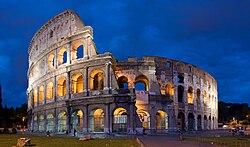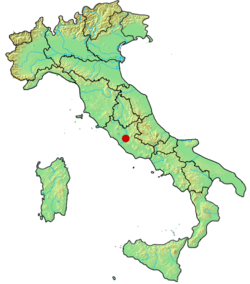Rome
Appearance
| Comune di Roma | |||
 |
|||
|
|||
| Nickname: The Eternal City | |||
| Motto: Senātus Populusque Rōmānus (SPQR) (Latin) | |||
 |
|||
| Coordinates: | |||
|---|---|---|---|
| Region | Lazio | ||
| Province | Rome (RM) | ||
| Founded | 21 April, 753 BC | ||
| Government | |||
| - Mayor | Giovanni Alemanno | ||
| Area | |||
| - City | 1,285 km² (496.1 sq mi) | ||
| - Urban | 5,352 km² (2,066 sq mi) | ||
| Elevation | 20 m (66 foot (unit of length)) | ||
| Population (December 2006)[1] | |||
| - City | 2,705,603 (1st) | ||
| - Density | 2,105.5/km² (4,664.8/sq mi) | ||
| - Urban | 4,013,057 | ||
| - Metro | 5,493,308 | ||
| Time zone | CET (UTC+1) | ||
| - Summer (DST) | CEST (UTC+2) | ||
| Postal codes | 00121 to 00199 | ||
| Area code(s) | 06 | ||
| Patron saints | Saint Peter and Saint Paul | ||
| Website: comune.roma.it | |||

Rome (Italian Roma), Italy ke sab se barraa city aur capital city hai. Ii Tiber Naddi pe hai aur iske population 2.8 million inhabitants log hai. Vatican City ii city ke north-west bhaag me hai.
According to legend, Rome was founded on April 21, 753 BC, by Romulus. He killed his twin brother named Remus, with whom he had been raised by a wolf, and became the first king of Rome.
Rome was built on the Sun hill, later named Palatine. It grew and is now built on seven hills:
Rome was the center of the Roman kingdom, later of the Roman Republic, then of the Roman Empire.
References
[badlo | source ke badlo]ref
- ↑ http://demo.istat.it/bilmens2006/index.html- ISTAT demographics

